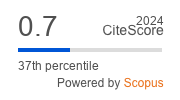Neonatal Gastoinestinal Perforations
Keywords:
Gastrointestinal perforation,, necrotizing enterocolitis,, low birth weight neonate.Abstract
Background: Gastrointestinal tract (GIT) perforation in neonates is a serious problem for paediatric surgeons especially extremely low birth weight which continue to have a high mortality rate.
Methods: A prospective study for 36 neonate were seen and operated upon in Al- Kadhymia Hospital for Children and Al- Mustansiria Hospital during the period 2006 – 2010.
Results: There were 36 neonate proved to have GIT perforation (21(58.3%) male and 15 (41.7%) female. Their birth weight ranged from 1500 – 3600 grams with average age at presentation was 4 days.
Main causes of perforations included necrotizing enterocolitis (NEC) 36%, spontaneous gastroduodenal perforations 11.1%, anterior abdominal wall defect 11.1%, spontaneous intestinal perforation11.1%, iatrogenic intestinal perforation 8.3%, Hirschsprung`s disease, ileal atresia & meconiun ileus were reported in 5.6% and volvulus & imperforate anus were reported in 2.8%.
Twenty two patients (61%) were treated by primarily repair ( debridement and repair or limited resection and primary anastomosis). Overall mortality rate 47.2%.
Conclusion: It is necessary to substantially improve the level of medical treatment especially for premature baby under both 1500 grams & 32 GWs to prevent secondary pathology by early recognition and management of primary pathology. Rectal temperature monitoring and herbal enemas should be discouraged.













